“The achievement of happiness requires not the satisfaction of our needs, but the examination and transformation of those needs.”
Stanley Cavell, Pursuits of Happiness (1984)
La virgen de agosto begins with a scene in which a character played by Sigfrid Monleón lends his flat in Madrid to a woman played by Itsaso Arana. Both of them talk about what they plan to do during summer, especially Monleón, as Arana’s character does not know yet. The landlord ends up talking about Stanley Cavell, an American philosopher who argued that there is almost a matrimonial relationship between cinema and philosophy.
The film tells the story of Eva (Itsaso Arana), a thirty-three-year-old woman who has decided to spend the month of August in Madrid, the city where she lives. The film barely reveals anything about Eva’s past; we only know that she is from Madrid. A friend lends her his apartment in the center of the Spanish capital for 30 days. Eva wanders through the streets of Madrid on the summer days when the San Lorenzo and Virgen de la Paloma festivities are celebrated. The protagonist lets herself be carried away by the senses and lets her life flow naturally, meeting former colleagues and friends from an old life that is no longer the same.
The fifth film by Jonás Trueba (son of Fernando Trueba and nephew of David Trueba) is presented almost as a para-documentary film that has no more pretensions than to follow a woman in her thirties on her walks through a magical and cinematic Madrid. Madrid, the city of haste, in August becomes a city that sleeps during the day and wakes up at night. A continuous contrast between bustle and silence given by the few Madrilenians who have stayed in the city and the tourists who, rather than visiting the great museums of the city, use these days to stroll and get closer to the verbenas of the popular festivities. Jonás Trueba’s cinema always revolves around characters – generally men and from an upper-middle social class – who reflect on their personal chores and the loves that have accompanied them throughout their lives. However, in La virgen de agosto his narrative becomes much more sophisticated and mature, and he chooses to move away from these manly characters to the purely feminine character of Eva. In addition, the theme of love moves into the background and although it is present – in the ex-boyfriend who is in the movie theatre or at the end of the film when she meets the character of Vito Sanz – it is completely reduced to something fleeting and temporary.
Time in La virgen de agosto is treated in a special way. Despite pinpointing the moments in time very well through natural elements such as the sun, water (it is a very summery movie), and even through specific dates from the beginning – from August 1st to 15th – the film is steeped in a strange sense of timelessness that comes close to the idea of temporal limbo. In fact, it seems that Eva’s character is in a transition period in her life in which she needs to listen to and understand herself without really knowing what her future holds.
The femininity of Eva
With that sensation of introspective listening of the female character in the film, the most representative and curious scene is the one in which some girls are found talking about their period pains in the cinema of the Círculo de Bellas Artes. She joins the conversation and decides to test out a kind of relaxation, pain reducing ritual with these girls. Also in the river scene, which we will deal with later, they talk about topics such as ovum freezing or the idea of being a single mother.
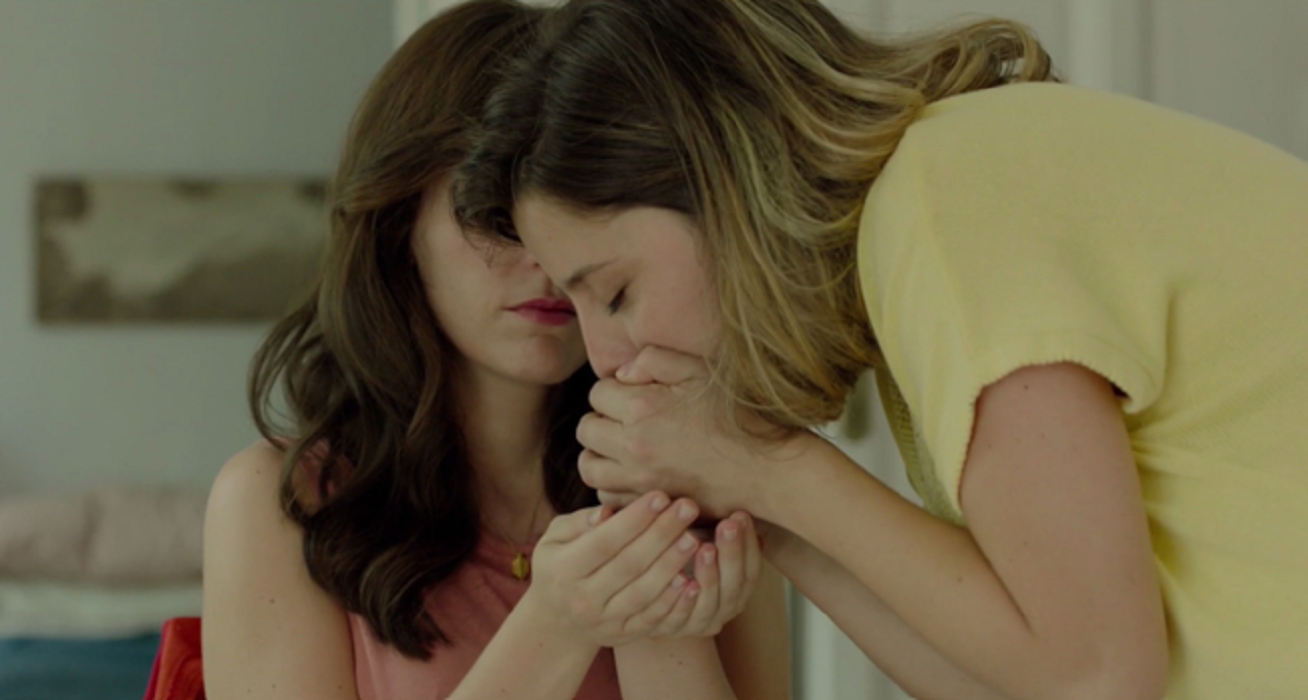
Eva and María doing reiki therapy
This feminist terrain is not a usual component of Jonás Trueba’s cinema. In fact, as we have said before, his cinema is characterized by being very masculine and he has been criticized because of that. In an interview, Trueba commented that his friend and filmmaker Mar Coll has always told him that he idealizes women in his films and turns them almost into platonic entities that have no voice in his work. However, in La virgen de agosto femininity is treated as the main theme, with a very powerful subtext that breaks with that idea of Trueba’s persona. In addition these criticisms were made a long time back, and already in Los exiliados románticos (2015) he decided to make fun of this issue by introducing a final dialogue between two women who say that if this were a movie (which it is), it would not pass the Bechdel test.
On the other hand, he was not alone in making this film so feminine. Itsaso Arana, the protagonist of the film, has also co-written the script or the “walk” of La virgen de agosto, something that does not seem relevant but which is key to approaching the issue of femininity in this story. Also, in a film in which so much weight falls on the character of Eva, it is very interesting that the actress and the filmmaker (who had previously worked together on La reconquista) got together to create the story from scratch.
This reunion is not only something that happens a lot in the narrative of the stories that Jonas Trueba tells, but it also happens in reality when making movies. We have already talked about the case of Itsaso Arana, but Vito Sanz, Isabelle Stoffel, and Francesco Carril have also appeared in several of his films. Trueba, like many auteur film directors, has a team with which he meets again in each of his films. The team of Los ilusos (its production company, not the film) is small and rarely does someone go missing for the production of one of the films. This is key when making a film like La virgen de agosto, since intimacy and the art of detail prevail. Likewise, this feeling of reunion is also conjured by the city of Madrid, a key setting in his films such as Todas las canciones hablan de mí (2010), La reconquista (2016), Los exiliados romanticos (2015) or Los ilusos (2013) (this time yes, the movie).
Madrid, the city of change
Madrid is like one more character in Trueba’s films, but La virgen de agosto is where it becomes most evident. In a video created by the Madrid Film Office about Madrid in Jonás Trueba’s cinema, the director comments that he builds his films from a walk. “The writing of the script happens during these walks“, he says. Trueba’s Madrid is presented as a city that is in constant change and movement; that is why he likes to shoot in Madrid, to capture that city that in each film has changed and become something different. An author who has reflected a lot on Madrid and who shares a similar perspective with Trueba is Basilio Martín Patino.
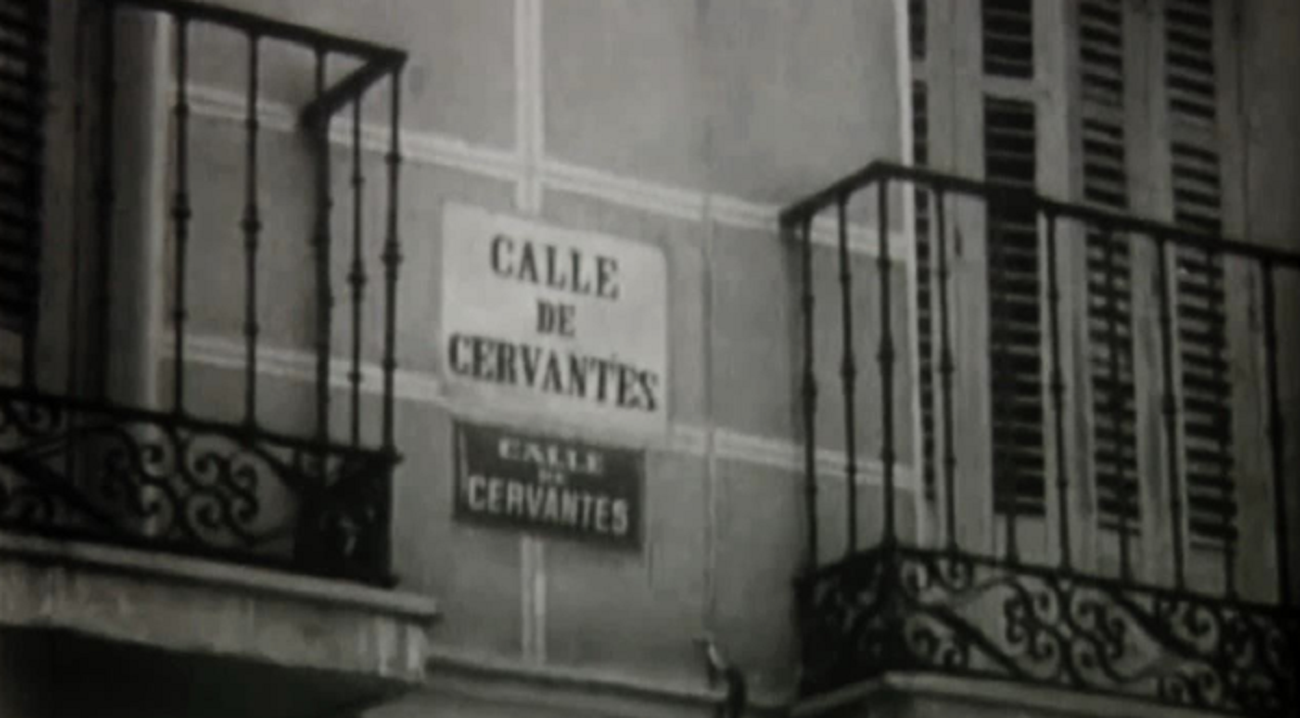
Still from Paseo por los letreros de Madrid (Basilio Martín Patino, 1968)
The Salamancan director fell in love with Madrid and in his short film (almost a topographical experiment) Paseo por los letreros de Madrid (1968) the whole history of the city is collected through its signs. This experiment would lead him to later make Madrid (1987), a fictional film that also has a lot of documentary elements. This film follows Hans (Rüdiger Vogler), a German filmmaker who is in Madrid to make a television program about the capital and the civil war. Accompanied by Lucía (Verónica Forqué), who is in charge of editing, he tours and records images of the current city. While walking the streets of Madrid, he realizes that the city has completely changed and the character is blocked by not understanding the change in this city that is no longer what it was before. This feeling of not understanding the city, but still seeing something mysterious and mystical in it is very similar to the feeling as told through Itsaso Arana in La virgen de agosto.
The Madrid of La virgen de agosto (and most of Trueba’s films) takes place around the Vistillas area and the Viaducto de Segovia, which is exactly the perimeter from which the city was founded. Therefore it is to be expected that this area has much more history and that there are more myths and stories around it. This connects with one of the most tender scenes in the film in which Eva’s character tells Agos (Vito Sanz) a little story about the Viaducto de Segovia.

Eva and Agos talking on the Viaducto de Segovia
Furthermore, as in Martin Patino’s film, the way in which La virgen de agosto is constructed, through these walks, refers to a touristy but at the same time empty Madrid. In fact, it’s funny how Eva’s attitude is almost like a visitor when it comes to her hometown. She is in a way rediscovering the city. She has changed and the city has changed; nothing is what it used to be. And not only has she changed, the characters that appear on her walks have also changed, creating an almost bitter feeling of not being able to understand what has happened. The most illustrative case is a conversation with her old friend Sofía, who already had a child. From the moment of giving birth her life has taken a big turn, and she has felt alone and without support of her friends ever since.
A more melancholic vision of Madrid
The idea of an empty Madrid is treated in La virgen de agosto as something positive, but at the same time there is a melancholic subtext given by the individualism of the big city. This “melancholic Madrid” is close to the one in La soledad (Jaime Rosales, 2007). That film tells how Adela (Sonia Almarcha) leaves her native León behind to go with her son to Madrid. At first she feels very overwhelmed by the change of environment. Almarcha wanders through the corridors of her new home in silence, in the same way that Arana does in La virgen de agosto. In fact, the first scene of Trueba’s film is formally reminiscent of Rosales’. Both play with fixed shots in which our protagonists enter and leave the action.

Comparison between La soledad (left) and La virgen de agosto (right)
In her text Una nueva vida en la ciudad. Las mujeres emigrantes del campo en el cine español de los albores del siglo XXI: “Solas” (1999), “Volver” (2006) y “La soledad” (2007), UC3M professor Mercedes Álvarez San Román compares these three films, and she remarks that the three female protagonists leave their towns in search of autonomy and must pass a series of tests that will have an impact on their inner world. Álvarez San Román comments on how urban space is liberating for women in the face of a rural environment dominated by patriarchy. The character of Eva in La virgen de agosto does not migrate from rural Spain to Madrid, but she does migrate from Madrid to Madrid to rediscover it and free herself, understanding and immersing herself in a city where loneliness and closeness reign at the same time.
El Jarama
Both women, Eva and Adela, have to start from scratch, and that leads them to have great fears. There is a key scene around the film’s mid-point where this idea is reflected upon. Eva goes to the river with her friend Sofía and three other people she met the day before. This scene is reminiscent of the novel El Jarama by Rafael Sánchez Ferlosio, in which a group of eleven young people from Madrid are going to spend the day in the countryside on a hot summer Sunday, near the Jarama river. This neorealist novel is very similar to the setting that Jonás Trueba recreates in the scene.
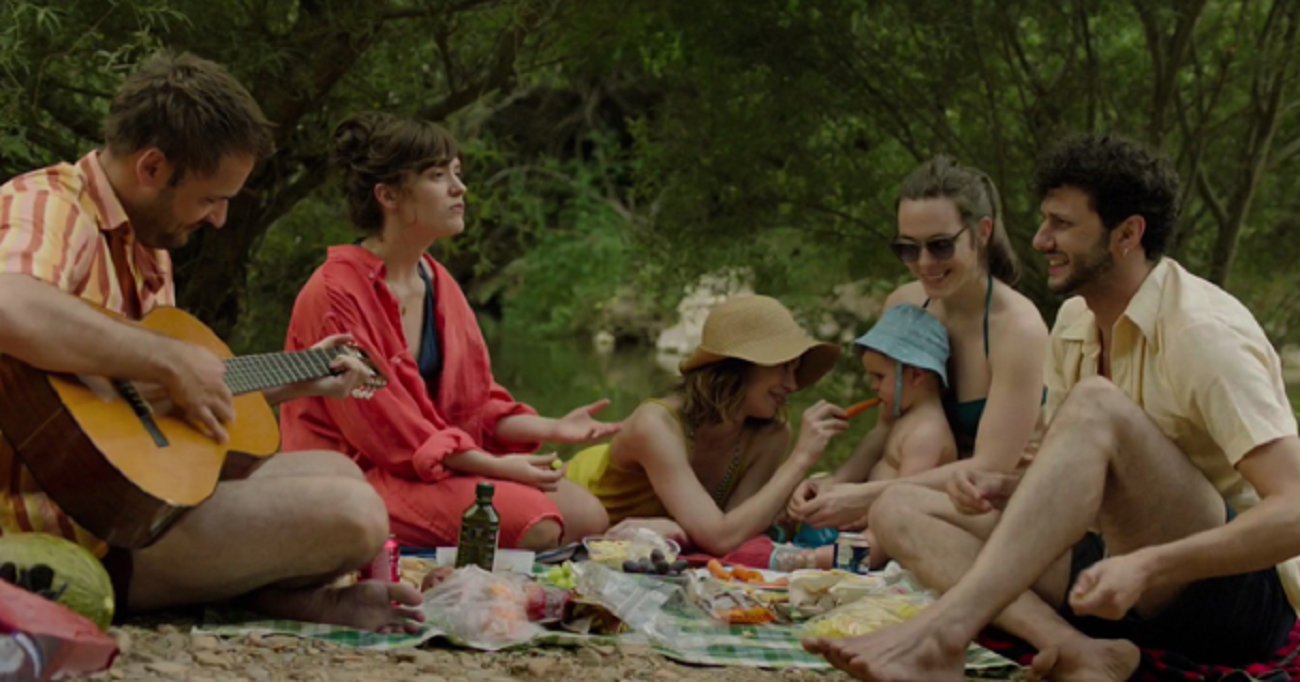
Eva and some friends having fun at the river
On that day, August 6, the different characters in La virgen de agosto reflect on the idea of leaving their hometown. Eva is the only one from Madrid, everyone else comes from abroad. Sofia’s character says that leaving the north helped her “to be”, to transform. One of the men in the scene says, “I don’t know if I left Wales because I am like this or if I am like this because I left Wales“. Olka (Isabelle Stoffel) agrees with him and adds that she has moved from country to country a lot, and each time it has been like starting from scratch. The camera shows us Stoffel at first, but at the point in which the fear of starting a new life is discussed the camera approaches Itsaso Arana, implying that she feels lost and cowardly for never having left the city. However, after all these reflections it ends up coming to the conclusion that the people who have never left are also brave. “It is easier to be free when nobody knows you, to reinvent yourself. But doing it while staying in your environment, I think it’s an act of bravery as well”, says Olka.
This act of courage connects very well with the premise of the film that says that staying in Madrid for the month of August is almost like an act of faith. Throughout the film we see elements of religion that give the story an air of mysticity: the act of faith, the name of Eva, her being 33 years old, the women who meet in the cinema being called María… until culminating with the character of Eva saying that she thinks she is pregnant, as far as we understand through an immaculate conception much like the Virgin Mary.
Light and sound as divine elements
Returning to the river scene, we can see a very specific cinematographic style that, although it has been shown throughout the film, here acquires greater splendor. La virgen de agosto plays a lot with sound. Eva is having a bath in the river and when she lets herself float in the water the sound of crickets stops and we hear a voice-over that says “become a real person”. The introduction of that extradiegetic voice breaks with all the naturalness of the film. It is the first time we have heard her speak in her head, and later on it will happen again as she writes her diary.
This sudden appearance of voice-over is very surprising, since during the entire film we have not heard any non-diegetic sound or music (except for the opening credits). Another exception happens when Eva meets Agos and we start hearing a sound similar to a broken guitar string. She is experiencing something new and it makes her feel uncomfortable. Something that characterizes the sound of the film is how natural it is, since even in street scenes and festivities it is difficult to hear the characters due to the bustle of the city. La virgen de agosto creates a continuous contrast between that bustling Madrid and the Madrid of silence. When you get home you don’t hear anything, and you are in a place of absolute peace. However, the streets of Madrid, be it in the verbenas or at night, are a noisy world.
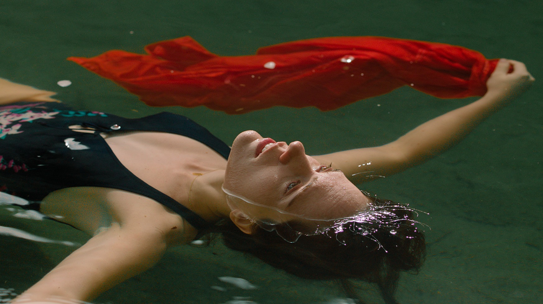
Itsaso Arana swimming in the river
Light also plays a very important role in the film. Jonás Trueba looks for the sun’s reflections on different surfaces, especially highlighting the reflection in the water of the river. But also the illumination of Itsaso Arana’s face as if it were a kind of divine entity that is guiding her on her way to “no one knows where”. At the beginning of the film, when Eva is left alone in her apartment, she unbuttons her shirt and lies down on the sofa. The shadow of tree leaves caresses her face, almost as if nature is speaking to her. This is enough for Eva to get excited and feel that she is connecting with herself.
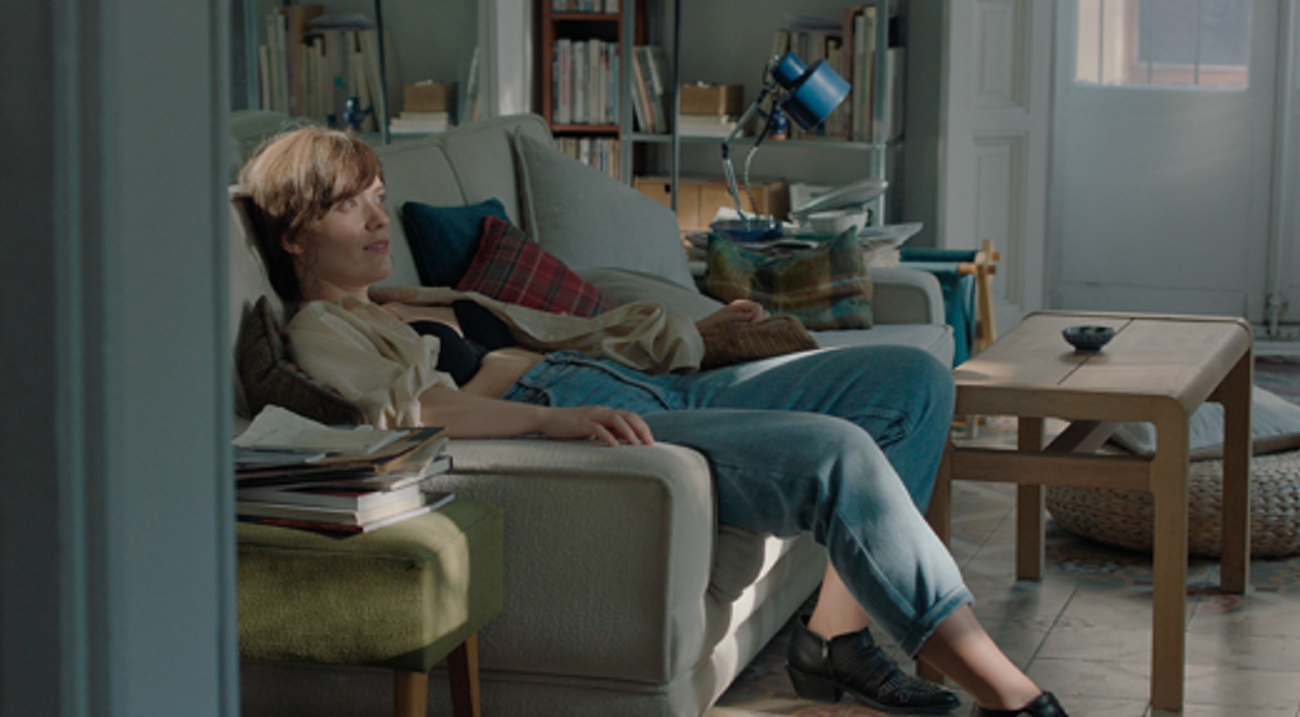
Itsaso Arana playing with the light of the sun
Jonás Trueba, a frenchified filmmaker
We have commented on the similarities of the film with the cinema of Basilio Martín Patino and Jaime Rosales, but if we move outside of Spain the biggest influence of this film is the cinema of the French filmmaker Eric Rohmer. We can speak both of an influence on the narrative as well as on the form. On the one hand La virgen de agosto is in continuous dialogue with Rohmer’s cinema regarding its ability to reflect on the great questions of life. Not only that, but the characters belong to a similar social class and the narrative is based on these spontaneous dialogues that arise between the characters. In addition, in the filmography of both of them chance plays a very important role, such as the fact that meeting a person on the street can change the course of your day, as when Eva meets Luis at the Archaeological Museum or meets Agos on the Viaducto de Segovia.
In an interview Trueba has commented on how he was interested in relating La virgen de agosto with The Green Ray (Le rayon vert, Eric Rohmer, 1986): “For me the interesting thing was to raise it again, but in reverse. In The Green Ray we see a desperate woman because she has no one to go on vacation with and she has to stay in her city for the summer. Here, however, we see a woman who decides to stay in her city on her own initiative”.

However, it is not only the narrative from which he drew directly. Trueba is also inspired by the aesthetics of the French director and takes the idea of structuring the film around different days in August as Rohmer did with July in Claire’s Knee (La genou de Claire, 1970) almost 50 years earlier. Also, in both films space is almost a character in its own right. It is not surprising that Trueba in La virgen de agosto pays homage to Rohmer after doing it before in Los exiliados romanticos. In this film there were very similar scenes and it ends on the lake of Annecy, where the whole plot of Claire’s Knee is situated. On the other hand, the aesthetics can be related to any Rohmer summer movie, since La virgen de agosto also resembles others such as A Summer’s Tale (Conte d’été, 1996), Pauline at the Beach (Pauline à la plage, 1983), or even An Autumn Tale (Conte d’automne, 1998).
BIBLIOGRAPHY
Álvarez San Román, M. (2015). Una nueva vida en la ciudad. Las mujeres emigrantes del campo en el cine español de los albores del siglo XXI: “Solas” (1999), “Volver” (2006) y “La
soledad” (2007). Iberic@l. Revue d’études ibériques et ibéro-américaines, 8, 85-97
Los ilusos films. La virgen de agosto | los ilusos films
https://www.losilusosfilms.com/la-virgen-de-agosto
José Antonio Pérez Guevara (August 18, 2019) Entrevista a JONÁS TRUEBA e ITSASO ARANA [Video]. Youtube.
https://www.youtube.com/watch?v=MfImK-h-0r0
Trueba, J. (Director). (2019). La virgen de agosto [Film]. Bteam Pictures
Ciudad de Madrid Film Office (November 18, 2019) Un paseo por el Madrid de Jonás Trueba [Video]. Youtube.
https://www.youtube.com/watch?v=dXTo3P6ZrNE&t=194s
Yuste, J. (July 29, 2019). Jonás Trueba: “La cultura no se puede medir como la contaminación”. El Cultural.
https://elcultural.com/jonas-trueba-la-cultura-no-se-puede-medir-como-la-contaminacion
